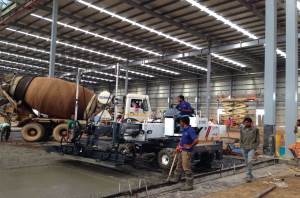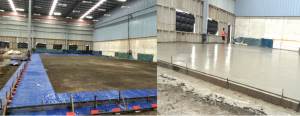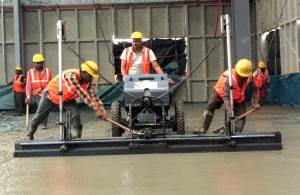Ground floor slabs in Industrial, Warehouses and Distribution Centres are integral to the efficient operation of the facility. They are the table top on which an operator runs his business. On the surface they appear to be one of the simplest parts of a structure to construct. However, this simplicity often leads to an underestimation of the design and construction requirements. A well designed and constructed floor will increase productivity, reduce maintenance of the building and increase the life of the equipment using the floor.
LTFS is a name that has become synonymous with quality flooring solutions. We bring in state-of-the-art machinery S 15 R laser screed machine with telescopic boom for the purpose of laying the floors Vs Conventional VDF Flooring. Also, we prefer Steel fibre reinforced concrete as an alternate to traditional mesh reinforcement.

Glued Steel Fibre Reinforced Concrete (SFRC)-provides a time saving and cost efficient solution for flooring. Being Multi dimensional reinforcement, it offers the following advantages:-
– Optimal Load bearing
– Optimal Crack control
– High fatigue resistance
– High impact resistance
Get more out of your slab
– Easier to maintain
– Longer lifespan
– Optimized Thickness
– Timesaving construction
– Better Performance
– The ductile steel fibre floor with stands moderate deformations minimizes curling of concrete slab.
– Easier and more accurate installation of Super flat floor.
Steel fibres are commonly used in concrete to provide structural (load-bearing) capacity and for the control of shrinkage-induced cracking. Steel fibres for reinforcing concrete are manufactured from cold-drawn wire and are used in grade or ground supported floors. Normally the preferred length is 60 mm, with aspect ratios of 80 (ratio of length to nominal diameter). In order to gain pull-out resistance fibres have hooked end profile. In ‘jointless’ slab construction, steel fibres at dosages in the order of 30-45 Kg/m3 are used to control the width and distribution of shrinkage-induced cracks.
In floors with sawn joints, dosages in the range. 12-20 Kg/m3 are typical. Manufacturers should be asked for data to demonstrate that dosages at the lower end of this range are effective as there is a lower limit below which a continuity of fibres in the concrete cannot be guaranteed. High Tolerance is the term referring to surface regularity. Surface regularity needs to be limited in two ways. The floor should have an appropriate flatness in order to limit the bumpiness and general stability in operation of the materials handling equipment, and an appropriate levelness to ensure that the building as a whole with all its static and mobile equipment can function satisfactorily. There are essentially two methods for defining floor flatness requirements. Floors are divided into Free Movement Areas (FM) and Defined Movement Areas (DM). TR34 Classification FM2 is recommended when specifying a new floor as this represents a good quality floor that can be achieved without excessive cost. For VNA applications a DM Specification (Superflat floor) should be used and the category is defined by the racking height.
“Superflat Floor”: Surfaces that support vehicular traffic along paths that are defined and do not change during the life of the floor surface (Defined Traffic). Defined traffic normally applies to very-narrow-aisles (VNA) warehouses in which VNA forklift trucks travel the same path, in the same direction, every day. Tolerances for conformance are necessary in the wheel tracks only, and they are measured by a special floor profiling instrument and defined by F number system as follows :-
FF (Floor Flatness)-is a measure of the waviness of the slab – Over 300 mm.
FL (Floor Levelness)-is a measure of the tilt of the slab – Over 3 m.

It is feared that steel fibres will stand out on surface and can be a hindrance in achieving high tolerance surface finish. Contrary to this, we would like to sight following two examples of fine tolerance floors with higher fibre dosage executed by us in the recent past.
a) Superflat floor for M/s. Wacker Metroerk Chemicals at Kolkata for an area of 2137 m2 with steel fibre dosage of 20 Kg/ m3 as per international standards of TR-34.
b) Jointless Floor for an area of 9000 m2 and panel size of 30 X 24 M for M/s. Knorr Bremse with steel fibre dosage of 30 Kg/m3 FM2 category as per international standards of TR-34.
At LTFSPL high tolerance SFRC (Steel Fibre Reinforced Concrete) floors are being constructed by us using cutting edge technology of laying floors with Laser Screed (Large line laser screed with a telescope boom of 6.1 M – Model S15 R & copperhead – small line Laser Screed machine) which does not requires guide rails to screed concrete, it eliminates the need of having formwork at regular intervals except at day joint thus making wide bay construction of pore size 300 to 2000 m2. This reduces construction joints by say 80% which is the weakest section of a floor.
… Delivering Faster – Flatter – Floors for Future!

